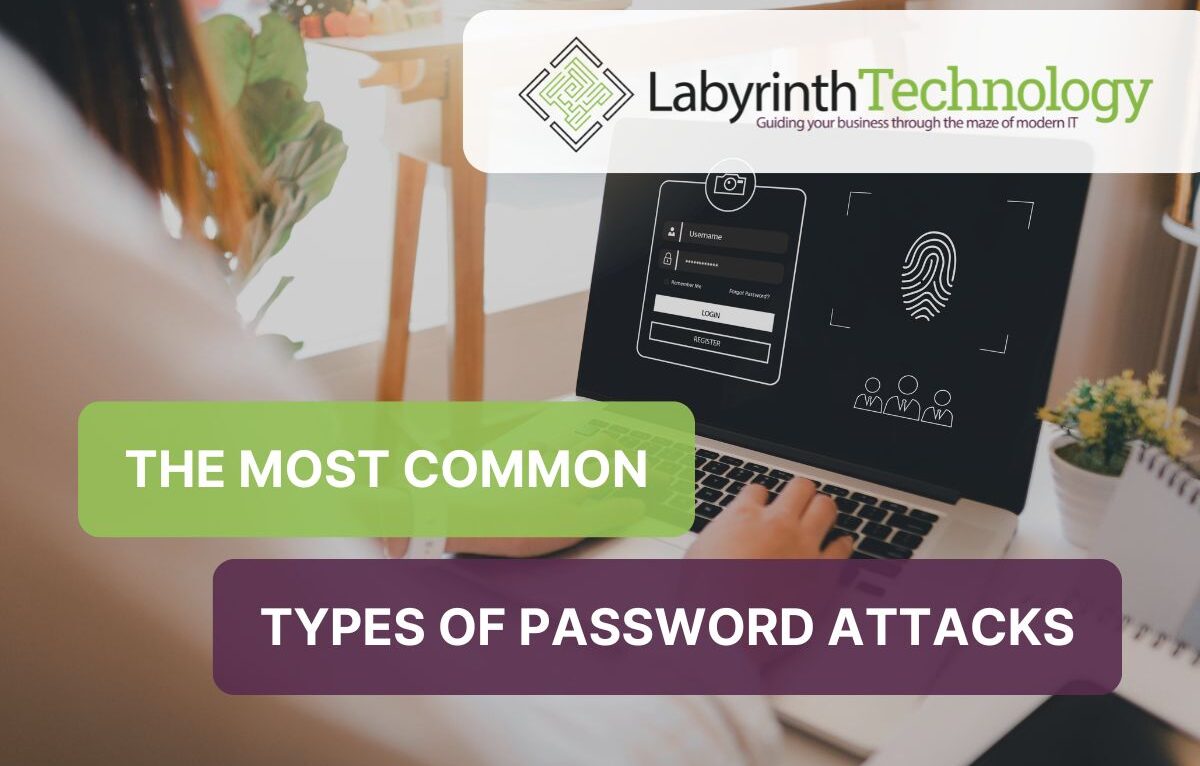
Cyber attacks are constantly evolving, becoming more sophisticated and harder to detect. Password attacks, in particular, have become one of the most common and effective methods used by cybercriminals to gain unauthorised access to systems, networks, and sensitive information. Understanding the most common types of password attacks and how to defend against them is crucial for maintaining the security of your business.
The 2024 Cyber Security Breaches Survey reveals that cyber security remains a critical concern for UK businesses. Half of the businesses and a third of charities experienced a cyber security breach or attack in the last 12 months, with phishing being the most common. Larger organisations are more likely to prioritise cyber security, conduct risk assessments, and have formal strategies in place. However, there is still a lack of awareness and implementation of government guidelines and accreditations. Incident response planning remains underdeveloped, especially among smaller organisations.
As these cyber threats grow, it’s crucial to stay informed about the various methods attackers use. The rest of this article will dive into the most common types of password attacks, explaining how they work and what you can do to protect your business. Knowledge is your first defence, so understanding these threats is key to staying secure.
One of the oldest and most basic types of password attacks is the brute force attack. In a brute force attack, hackers use automated tools to try every possible combination of characters until the correct password is found. While this method may seem time-consuming, the increasing power of modern computers and the availability of automated software have made brute force attacks a viable threat, particularly against weak passwords.
For example, if a password is simply “123456” or “password,” it could be cracked in seconds. According to recent statistics, these kinds of weak passwords are still incredibly common. Despite awareness campaigns, many users continue to choose easily guessable passwords, making them vulnerable to brute force attacks.
To defend against brute force attacks, businesses should enforce the use of strong, complex passwords that include a mix of upper and lower case letters, numbers, and symbols. Additionally, implementing multi-factor authentication (MFA) adds an extra layer of security, making it significantly harder for attackers to gain access even if they crack the password.
Dictionary attacks are similar to brute force attacks but are slightly more refined. Instead of trying all possible combinations, attackers use a precompiled list of commonly used passwords, known as a dictionary, to guess the correct password. These dictionaries are often based on leaked passwords from previous data breaches, making them highly effective.
For example, if your password is a simple word like “sunshine” or “football,” a dictionary attack could likely break it in seconds. With more than 50% of users admitting to reusing passwords across multiple sites, the threat of dictionary attacks has never been more relevant.
To counteract dictionary attacks, businesses should encourage employees to avoid using common words or phrases as passwords. Passwords should be unique and not found in any dictionary or common password list. Again, MFA can provide an additional safeguard against this type of attack.
Phishing is one of the most prevalent and dangerous types of password attacks today. In a phishing attack, hackers trick users into providing their passwords by pretending to be a legitimate entity, such as a bank, a colleague, or even a well-known company. These attacks often come in the form of emails or messages that contain a link to a fake website designed to look authentic.
For instance, you might receive an email that appears to be from your bank, asking you to “verify your account details.” If you enter your password on the fake site, the attacker now has access to your account. According to a report by Verizon, over 90% of data breaches start with a phishing email, highlighting the critical importance of educating employees about this threat.
Defending against phishing attacks involves a combination of technology and education. Anti-phishing tools can help filter out malicious emails, but the most effective defence is training employees to recognise phishing attempts. Businesses should also implement MFA wherever possible, as it can prevent attackers from accessing accounts even if they manage to steal a password.

Credential stuffing is a method where attackers use stolen username and password combinations from previous breaches to try to gain access to other accounts. This type of attack relies on the fact that many users reuse passwords across multiple platforms. If your password is compromised in one breach, attackers may be able to use it to access your other accounts.
For example, if your LinkedIn credentials were exposed in a data breach and you use the same password for your work email, a credential stuffing attack could allow hackers to access your business email account. With billions of credentials available on the dark web, this type of attack is becoming increasingly common.
The best defence against credential stuffing is to ensure that employees use unique passwords for every account. Password managers can help manage multiple complex passwords, reducing the temptation to reuse the same one. Additionally, enabling MFA for all accounts can thwart attackers even if they have the correct password.
Keyloggers are malicious software that records every keystroke made on a computer, including passwords. Once installed on a victim’s device, a keylogger can capture all types of sensitive information, including login credentials, without the user knowing.
For instance, if a keylogger is installed on a company laptop, it can record passwords as employees log into their accounts, giving attackers access to critical business information. Keyloggers are often distributed through phishing emails, infected websites, or compromised downloads.
To protect against keylogger attacks, businesses should ensure that all devices are equipped with up-to-date anti-malware software. Regularly scanning for and removing any malicious software is crucial. Educating employees about the dangers of downloading unverified software and clicking on suspicious links can also reduce the risk of keylogger infections.
A Man-In-The-Middle attack is a form of cyber attack where a hacker intercepts and potentially alters the communication between two parties without their knowledge. This type of attack is particularly dangerous because the attacker can eavesdrop on the conversation, steal sensitive information, and even inject malicious content into the communication.
These attacks are often carried out on unsecured or poorly secured networks, such as public Wi-Fi. For example, if you’re using a coffee shop’s free Wi-Fi, a hacker on the same network could intercept the data being transmitted between your device and the websites you visit. This could include login credentials, financial information, or private communications.
One common method of executing such attack involves the attacker setting up a fake Wi-Fi hotspot that looks legitimate. When users connect to this hotspot, the attacker can monitor all the traffic passing through it. Even on seemingly secure networks, an attacker can use techniques like DNS spoofing, where they manipulate the DNS server to redirect traffic to a malicious website without the user’s knowledge.
To protect against Man-In-The-Middle attacks, businesses should ensure that all communication channels are encrypted. Using HTTPS on websites and secure email protocols like SSL/TLS can help prevent attackers from intercepting data. Employees should also be educated about the risks of using public Wi-Fi and encouraged to use VPNs to secure their internet connections.
Strong password practices are essential in defending against various types of password attacks. One of the most effective methods to enhance security is implementing multi-factor authentication (MFA). MFA adds an extra layer of protection by requiring users to provide two or more verification factors, such as a password and a fingerprint or a one-time code sent to a mobile device. Even if an attacker manages to obtain your password, they would still need the second factor to gain access, making it much harder for them to breach your account.
Password managers are another crucial tool in maintaining strong password security. These tools generate and store complex, unique passwords for each of your accounts, reducing the risk of using easily guessable or reused passwords. With a password manager, you only need to remember one master password, while the tool handles the rest, ensuring that your accounts are secured with strong, randomised credentials.
In addition to using MFA and password managers, it’s important to regularly update your passwords and avoid using common words or phrases that could be easily guessed through dictionary attacks. Encourage your team to adopt these practices and to stay vigilant against phishing attempts, where attackers may try to trick them into revealing their passwords. Educating your staff about these threats and how to respond to them is vital for maintaining robust security across your organisation.
At Labyrinth Technology, we advocate for these best practices and offer solutions that help you implement them seamlessly. From setting up MFA across your systems to providing guidance on secure password management, we’re here to help you protect your business from growing cyber threats.

At Labyrinth Technology, we understand the complexities of cyber security and the importance of protecting your business against password attacks. Among the various types of password attacks, each poses unique challenges that can significantly impact your organisation. Our expert team is dedicated to providing you with tailored cyber security services that address your specific needs. We focus on enhancing your organisation’s security posture by implementing effective access management solutions and educating your staff about the latest cyber threats.
What sets us apart is our commitment to staying ahead of the curve. We leverage the latest technologies, including cloud-based solutions like Microsoft Azure, to offer scalable and robust cyber defences. Whether you’re dealing with increased threats or looking to protect critical infrastructure, our cyber security solutions are designed to reduce risk and ensure your business remains secure.
We don’t just offer solutions; we enable clients to achieve their business objectives while maintaining a secure environment. With our knowledge, expertise, and personalised approach, you can trust Labyrinth Technology to be your reliable IT partner. Let us help you build a secure, resilient business. Contact us today to learn more about how we can support you.
Empowering London Businesses with Efficient IT Solutions to Save Time and Stay Ahead of the Competition.